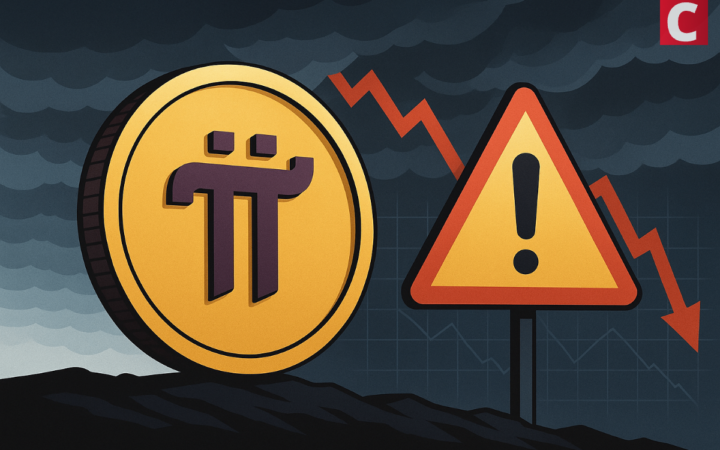
Charles Hoskinson Reaffirms Commitment to Bitcoin DeFi, Cardano Innovations
Cardano founder Charles Hoskinson has reiterated the network’s commitment to Bitcoin DeFi while spotlighting projects like Midnight, Leios, and Midgard.

Cardano founder Charles Hoskinson has reiterated the network’s commitment to Bitcoin DeFi while spotlighting projects like Midnight, Leios, and Midgard.

Cetus Protocol has received approval of the on-chain vote to transfer the previously quarantined funds on Sui to a multisig trust wallet.

BlackRock’s Bitcoin ETF (IBIT) recorded $5.95 billion in inflows during May 2025, adding 56,798 Bitcoins to its holdings, with AUM hitting $70 billion.

Ethereum’s on-chain metrics, along with a sustained 6% annualized premium in ETH futures, suggest a potential recovery to $3,000.

A 4.53 million whale withdrawal and the SEC’s decision to back off meme coin oversight have sent shockwaves through the $TRUMP market.

CoinGlass crypto liquidation heatmap shows that Bitcoin and Ethereum suffered the most from the $714 million losses recorded.

Binance CEO urges P2P users to verify trades, avoid scams, and use in-app tools to stay safe as fraud risks rise with platform growth.

On-chain metrics like the Chaikin Money Flow (CMF) and Squeeze Momentum Indicator highlight rising selling pressure and bearish momentum for Pi Network.

PEPE plunged 11% in the last 24 hours, wiping out over $650 million in market cap as a major whale deposit on Binance sparks sell-off fears.

The SEC’s new guidance confirms that crypto staking activities on PoS blockchains, including Ethereum, are exempt from securities registration.

The president of the Central African Republic has disclosed plans to tokenize land using the country’s Solana-based meme coin.

Saudi Aramco is not currently working with the XRP Ledger, as a recently circulating partnership document may be fraudulent.

Thai SEC is blocking access to five major crypto exchanges, citing unlicensed operations and urging users to secure their assets.

Hyperliquid has demonstrated its ability to manage high-volume trades, successfully handling crypto trader James Wynn’s $1 billion positions.

As the Champions League final nears, Paris Saint-Germain has revealed that it has been accumulating Bitcoin since 2024 and continues to hold it.
For the average millennial or at least anyone that pays attention to the business world, the term “cryptocurrency” would not seem like such a strange word. If that is, then the terms Bitcoin, Ethereum or at least Blockchain should ring a bell. One might wonder, why are these terms suddenly so prevalent, especially cryptocurrency news? Computing is getting rather pervasive and the society is leaning towards digital services. The finance world too isn’t spared as the disruption of technology into this sector has fostered the birth and development of Fintech organizations.
These Fintech organizations look to digitize payments and transactions, offering the same services that are currently in existence but in a better, efficient and more effective way.
Blockchain is the network upon which most of these cryptocurrencies operate on. The history of blockchain and bitcoin, in particular, does not have a definite story. In 2009, an individual or group of individuals known to be “Satoshi Nakomoto” developed and published the technology to allow people make digital payments between themselves anonymously without having an external party to verify or authorize the transfer of the currency being exchanged.
Although technologies like this might seem rather complex, understanding how Blockchain works is quite easy, given that one has a basic idea of how networks work. Blockchain is simply a database shared between several users, containing confirmed and secured entries. It is a network, where each entry has a connection to its previous entry.
This technology affords a very secure model whereby every record in the database cannot be tampered with. Apart from the stellar security that this network offers, the transparency and speed at which the network operates give it an edge over the conventional way of conducting transactions.
In simple terms, cryptocurrencies are just monies in digital form, transacted via digital means and over a digital network. The transfer of these currencies is utilized with cryptography and the aforementioned blockchain network. Up until the 2010s, cryptocurrencies were not really known until Bitcoin made its breakout and this gave rise to the birth of new cryptocurrencies.
Cryptocurrencies have had their fair share of bullish and bearish trends, going to show how unstable they can be. The latest cryptocurrency news reports lots of people predicting prices for various cryptocurrencies in the years to come but no-one can say for sure.
Blockchain, on the other hand, is making its way into pervasive computing, especially IoT, giving way for the development of new solutions that embrace data security and transparency.